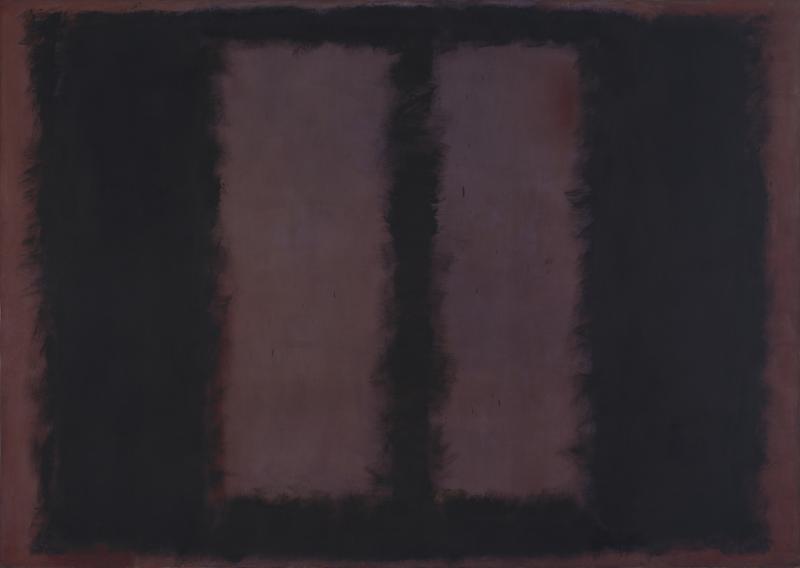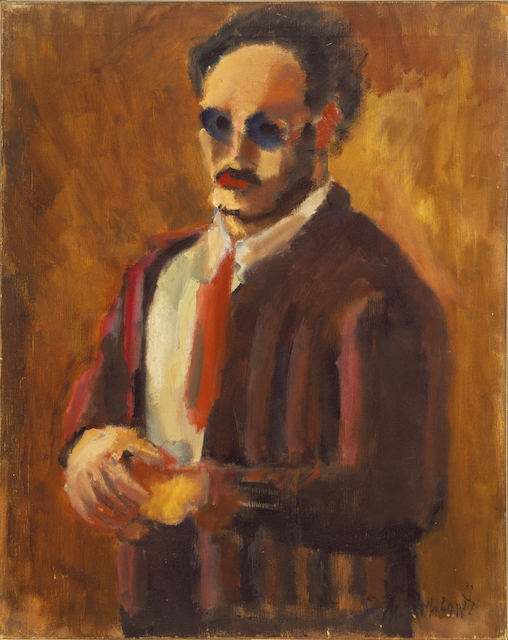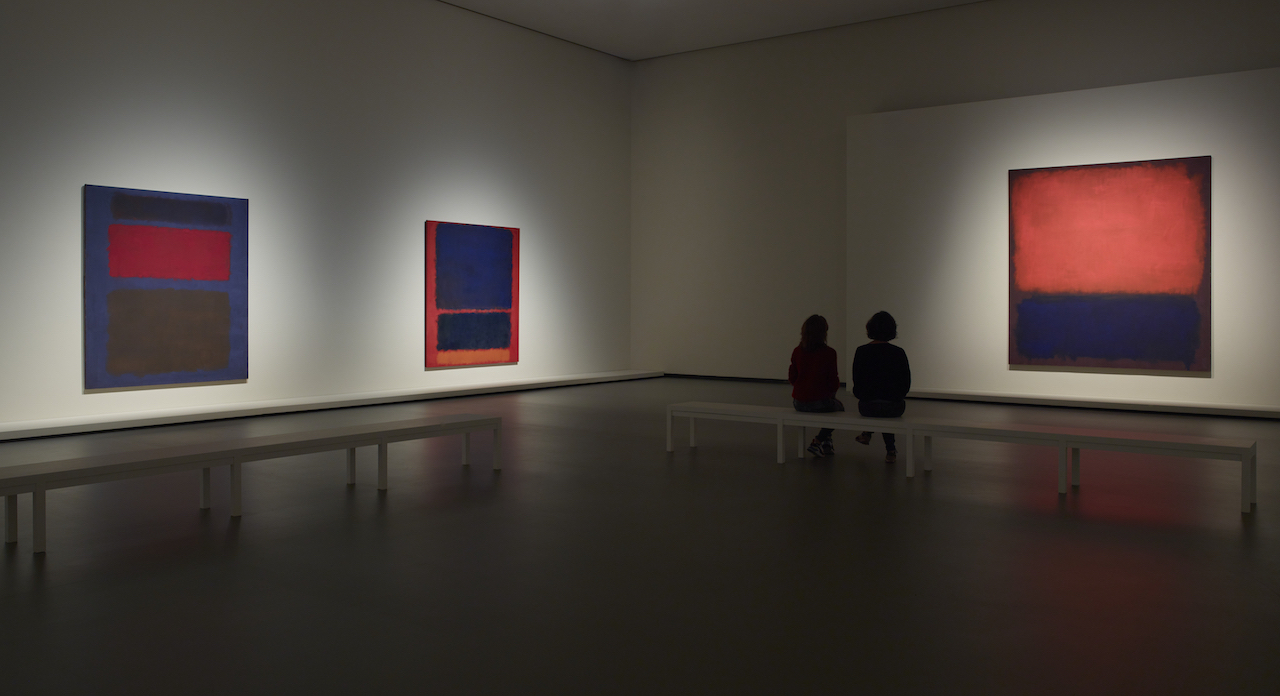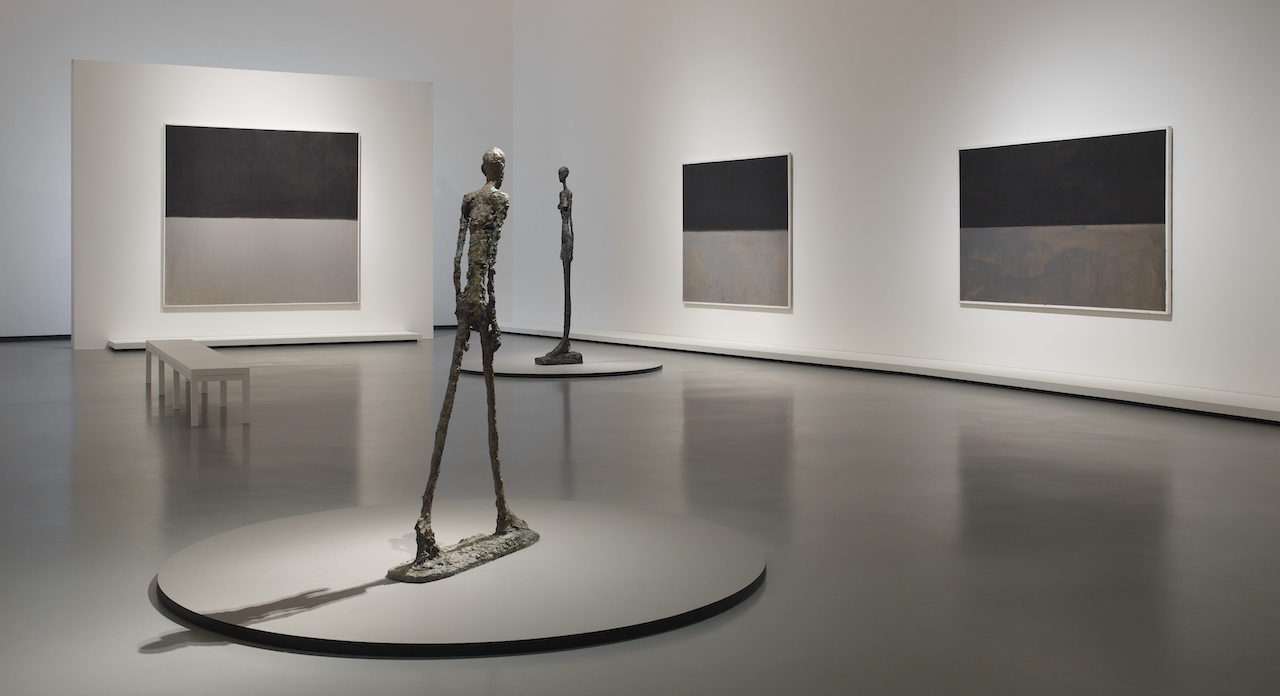Mark Rothko, Fondation Louis Vuitton, Paris review - a show well worth the trip across the Channel | reviews, news & interviews
Mark Rothko, Fondation Louis Vuitton, Paris review - a show well worth the trip across the Channel
Mark Rothko, Fondation Louis Vuitton, Paris review - a show well worth the trip across the Channel
Abstraction with emotion and soul in a landmark retrospective

The vast and various spaces of Frank Gehry’s monumental Fondation Louis Vuitton in Paris suit the needs of the thrilling Mark Rothko exhibition now inhabiting its labyrinthine multi-storey suite of galleries.
Some of the 115 works on display require a kind of intimacy – enclosed spaces with the feel of a chapel rather than the classsic antiseptic white cube – and others benefit from wider vistas, in which his relentless explorations can breathe, standing alone while being connected with other works from the same period. With help from the artist’s son Christopher Rothko, the curator Suzanne Pagé has done a marvellous job, balancing backstory and context with a celebration of the work on its own terms.
Rothko’s adventurous journey from figurative to abstract art fills the first few rooms, though those labels hardly do justice to work that eludes art historical definitions. His work in the 1930s, portraits (Self Portrait, 1936, pictured below) and views of the New York subway, suggest an approach to representation that plunges beneath the surface of appearances, playing with the juxtaposition of mostly muted colours and a view that eschews the easier ways of dealing with perspective and depth. These paintings are both subjective and detached, as if already seeking another dimension.
 In the 1940s, along with other American artists who had become familiar with the writings of CG Jung, and influenced by the imaginal work of the surrealists, Rothko explored classical mythological themes as well as totemic figures. This move into the archetypal suggests a further move from everyday surface reality, a kind of staging post or transitional phase in which the imagination gradually takes over. The images are drawn from collective cultural heritage, resonating with the artist’s vision. We move, with Rothko, from the particular of a self-portrait or a cityscape to evocations of a dream-world inhabited by images that transcend the particular (Slow Swirl at the Edge of the Sea, 1944, pictured below) and reach for something more universal – or as Jung might have put it, the "collective unconscious".
In the 1940s, along with other American artists who had become familiar with the writings of CG Jung, and influenced by the imaginal work of the surrealists, Rothko explored classical mythological themes as well as totemic figures. This move into the archetypal suggests a further move from everyday surface reality, a kind of staging post or transitional phase in which the imagination gradually takes over. The images are drawn from collective cultural heritage, resonating with the artist’s vision. We move, with Rothko, from the particular of a self-portrait or a cityscape to evocations of a dream-world inhabited by images that transcend the particular (Slow Swirl at the Edge of the Sea, 1944, pictured below) and reach for something more universal – or as Jung might have put it, the "collective unconscious".  The inner journey reflected in this period of Rothko’s work seems to lead almost seamlessly – or even intentionally – into pure abstraction, as if the insubstantiality of myth, as expressions of energy in its various forms, introduced the possibility of paintings we refer to as abstract. Rothko was at pains to disassociate himself from the notion of abstraction, suggesting instead, over and over, that his work was packed full of emotion, as if the abstraction he rejected were a means of stripping the painted image of felt experience, and focusing instead on the sharp edges and delineations imposed by the intellect. The origins of abstraction in the works of Malevich, Mondrian, Kandinsky and others was indeed always rooted in spiritual exploration, as if their paintings worked as yantras, those combinations of shapes and colours, used as aids to meditation in Tantric and Hindu practice.
The inner journey reflected in this period of Rothko’s work seems to lead almost seamlessly – or even intentionally – into pure abstraction, as if the insubstantiality of myth, as expressions of energy in its various forms, introduced the possibility of paintings we refer to as abstract. Rothko was at pains to disassociate himself from the notion of abstraction, suggesting instead, over and over, that his work was packed full of emotion, as if the abstraction he rejected were a means of stripping the painted image of felt experience, and focusing instead on the sharp edges and delineations imposed by the intellect. The origins of abstraction in the works of Malevich, Mondrian, Kandinsky and others was indeed always rooted in spiritual exploration, as if their paintings worked as yantras, those combinations of shapes and colours, used as aids to meditation in Tantric and Hindu practice.
With Rothko, contemplation is the key, rather than a search for meaning, or mere pleasure in the experience colour or form. Rothko’s path from the late 1940s on, reaches inexorably towards a kind of purification, and the creation of works that call for the presence of the person before them. A form of dedicated yet relaxed attention that tunes into the painting’s own inescapable presence. It might be easy to dismiss the sheer beauty of his paintings, their power of seduction, but they offer so much more than that. They demand a kind of silence. A silence of the mind’s doubts, chatter and ceaseless questions. Unlike much of his abstract contemporaries, Rothko’s paintings are portals. Not just in the way that all painting opens up a universe within its frame, but as a two-way opening that offers the viewer a way inwards, through the magic of the image itself. Rothko was very conscious of this: the paintings hung, according to his wishes and included in a special very contained space in the Fondation Vuitton exhibition, in the Washington Phillips Collection, were designed to hang close to floor level, so as to invite such a reciprocal encounter. Each of the paintings from the 1950s until Rothko’s death in 1970 offers such an extraordinary encounter: a moment of self-discovery, on a non-personal basis, with one self, or dare it be said “the Self” .  The exhibition is inevitably crowded, for this is a crowd-puller, and there’s a wide range of guided tours, from the erudite ones for connoisseurs of art history to others designed for babies up to 18 months old, but the paintings and the generous space of the building ensure that the experience transcends the hustle and bustle – perhaps even speak out on behalf of the moments of reflective engagement that each work so powerfully invites. At least if you can be bothered to stop a while and look, rather than voraciously collect images on a cell phone as so many visitors seem to be compelled to do.
The exhibition is inevitably crowded, for this is a crowd-puller, and there’s a wide range of guided tours, from the erudite ones for connoisseurs of art history to others designed for babies up to 18 months old, but the paintings and the generous space of the building ensure that the experience transcends the hustle and bustle – perhaps even speak out on behalf of the moments of reflective engagement that each work so powerfully invites. At least if you can be bothered to stop a while and look, rather than voraciously collect images on a cell phone as so many visitors seem to be compelled to do.
The Rothko room from Tate Britain – the American painter's masterpiece is permanently in the galleries of British art, as he insisted that his works should hang near the Turners he so loved – has been moved to Paris, along with many works from the USA and in the private collections of the Rothko family. The very large dark maroon and black works from London (Black on Maroon, 1958, pictured above) don’t have quite the power that they do at the Tate: they need a contained space for all-embracing absorption. Placing them here in something of a thoroughfare weakens their collective impact – one of the few disappointments in a mostly impeccable presentation. The contrary is true of the very high-ceilinged spaces in which Rothko’s almost monochrome paintings from the early 60s are shown alongside several very large Giacometti figures, striding and standing (pictured above). There had been a plan for a Giacometti-Rothko installation at the UNESCO headquarters in Paris, but it never happened. The American painter felt a strong affinity with the sculptor. The greys, blacks and off-whites of this period match the texture and hues of the massive yet delicate sculptures. But, most of all, it’s the indeterminate edge of every form, whether painted or sculpted that stands out. There’s nothing neat or hard-edged here, none of the visual certainties of so much minimalism, only the indeterminacy of that place where matter and space collide, or rather melt into each other.
The contrary is true of the very high-ceilinged spaces in which Rothko’s almost monochrome paintings from the early 60s are shown alongside several very large Giacometti figures, striding and standing (pictured above). There had been a plan for a Giacometti-Rothko installation at the UNESCO headquarters in Paris, but it never happened. The American painter felt a strong affinity with the sculptor. The greys, blacks and off-whites of this period match the texture and hues of the massive yet delicate sculptures. But, most of all, it’s the indeterminate edge of every form, whether painted or sculpted that stands out. There’s nothing neat or hard-edged here, none of the visual certainties of so much minimalism, only the indeterminacy of that place where matter and space collide, or rather melt into each other.
This is perhaps the feature of Rothko’s mature work that I found most striking: the way in which the edges between shades and colours melt into each other, a seeming lack of focus which invites a mind in constant search of certainty to simply let go. This blurring of edges produces extraordinary vitality, a subtle vibration rather than decisive movement. This helps express the emotion which Rothko sought to communicate, or which imposed itself on the work, as he embraced the impersonal with such unstinting vigour and commitment. This is a very moving exhibition, with a depth and quality that makes it possible to spend much longer than can normally be done with a big art show. My tolerance for looking at art and my capacity for serious attention is usually limited to an hour or two. Here, I found that I was more than willing to immerse myself, painting by painting, room after room, and enjoy a series of unique encounters that filled me with awe, wonder and a good deal of joy.
rating
Share this article
The future of Arts Journalism
You can stop theartsdesk.com closing!
We urgently need financing to survive. Our fundraising drive has thus far raised £49,000 but we need to reach £100,000 or we will be forced to close. Please contribute here: https://gofund.me/c3f6033d
And if you can forward this information to anyone who might assist, we’d be grateful.

Subscribe to theartsdesk.com
Thank you for continuing to read our work on theartsdesk.com. For unlimited access to every article in its entirety, including our archive of more than 15,000 pieces, we're asking for £5 per month or £40 per year. We feel it's a very good deal, and hope you do too.
To take a subscription now simply click here.
And if you're looking for that extra gift for a friend or family member, why not treat them to a theartsdesk.com gift subscription?
more Visual arts
 'We are bowled over!' Thank you for your messages of love and support
Much-appreciated words of commendation from readers and the cultural community
'We are bowled over!' Thank you for your messages of love and support
Much-appreciated words of commendation from readers and the cultural community
 Photo Oxford 2025 review - photography all over the town
At last, a UK festival that takes photography seriously
Photo Oxford 2025 review - photography all over the town
At last, a UK festival that takes photography seriously
![SEX MONEY RACE RELIGION [2016] by Gilbert and George. Installation shot of Gilbert & George 21ST CENTURY PICTURES Hayward Gallery](https://theartsdesk.com/sites/default/files/styles/thumbnail/public/mastimages/Gilbert%20%26%20George_%2021ST%20CENTURY%20PICTURES.%20SEX%20MONEY%20RACE%20RELIGION%20%5B2016%5D.%20Photo_%20Mark%20Blower.%20Courtesy%20of%20the%20Gilbert%20%26%20George%20and%20the%20Hayward%20Gallery._0.jpg?itok=7tVsLyR-) Gilbert & George, 21st Century Pictures, Hayward Gallery review - brash, bright and not so beautiful
The couple's coloured photomontages shout louder than ever, causing sensory overload
Gilbert & George, 21st Century Pictures, Hayward Gallery review - brash, bright and not so beautiful
The couple's coloured photomontages shout louder than ever, causing sensory overload
 Lee Miller, Tate Britain review - an extraordinary career that remains an enigma
Fashion photographer, artist or war reporter; will the real Lee Miller please step forward?
Lee Miller, Tate Britain review - an extraordinary career that remains an enigma
Fashion photographer, artist or war reporter; will the real Lee Miller please step forward?
 Kerry James Marshall: The Histories, Royal Academy review - a triumphant celebration of blackness
Room after room of glorious paintings
Kerry James Marshall: The Histories, Royal Academy review - a triumphant celebration of blackness
Room after room of glorious paintings
 Folkestone Triennial 2025 - landscape, seascape, art lovers' escape
Locally rooted festival brings home many but not all global concerns
Folkestone Triennial 2025 - landscape, seascape, art lovers' escape
Locally rooted festival brings home many but not all global concerns
 Sir Brian Clarke (1953-2025) - a personal tribute
Remembering an artist with a gift for the transcendent
Sir Brian Clarke (1953-2025) - a personal tribute
Remembering an artist with a gift for the transcendent
 Emily Kam Kngwarray, Tate Modern review - glimpses of another world
Pictures that are an affirmation of belonging
Emily Kam Kngwarray, Tate Modern review - glimpses of another world
Pictures that are an affirmation of belonging
 Kiefer / Van Gogh, Royal Academy review - a pairing of opposites
Small scale intensity meets large scale melodrama
Kiefer / Van Gogh, Royal Academy review - a pairing of opposites
Small scale intensity meets large scale melodrama
 Jenny Saville: The Anatomy of Painting, National Portrait Gallery review - a protégé losing her way
A brilliant painter in search of a worthwhile subject
Jenny Saville: The Anatomy of Painting, National Portrait Gallery review - a protégé losing her way
A brilliant painter in search of a worthwhile subject
 Abstract Erotic, Courtauld Gallery review - sculpture that is sensuous, funny and subversive
Testing the boundaries of good taste, and winning
Abstract Erotic, Courtauld Gallery review - sculpture that is sensuous, funny and subversive
Testing the boundaries of good taste, and winning
 Edward Burra, Tate Britain review - watercolour made mainstream
Social satire with a nasty bite
Edward Burra, Tate Britain review - watercolour made mainstream
Social satire with a nasty bite

Add comment